Diversity and Ecosystem Services of Trichoptera
Abstract
1. Introduction
2. Diversity
3. Ecosystem Services
4. Phylogenetic Relationships of Trichoptera Families
5. Evolution of Diversity and Ecosystem Services in Trichoptera
5.1. Annulipalpia Stationary Retreats and Feeding: Filtering-Collecting-Grazing-Gardening-Ambushing
5.2. Integripalpia Basal-Lineage Case Making and Feeding: From Caselessness to Living under Domes and Collecting-Grazing-Piercing-Parasitizing-Pursuing
5.3. Integripalpia: Tubular Cases and Feeding
5.4. Evolution of Angiosperm Phytophagy and Case Material
6. Conclusions
Author Contributions
Funding
Acknowledgements
Conflicts of Interest
References
- Holzenthal, R.W.; Blahnik, R.J.; Prather, A.L.; Kjer, K.M. Order Trichoptera Kirby, 1813 (Insecta), Caddisflies. In Linnaeus Tercentenary: Progress in Invertebrate Taxonomy; Zhang, Z.-Q., Shear, W.A., Eds.; Zootaxa2007, 1668, 639–698. [CrossRef]
- Wiggins, G.B.; Currie, D.C. Chapter 17, Trichoptera families. In An Introduction to the Aquatic Insects of North America, 4th ed.; Merritt, R.W., Cummins, K.W., Berg, M.B., Eds.; Kendall/Hunt: Dubuque, IA, USA, 2008; pp. 439–480. ISBN 978-0-7575-5049-2. [Google Scholar]
- Adler, P.H.; Foottit, R.G. Introduction. In Insect Biodiversity: Science and Society, 2nd ed.; Footitt, R.G., Adler, P.H., Eds.; John Wiley & Sons: Hoboken, NJ, USA, 2017; Volume 1, pp. 1–7. ISBN 9781118945537. [Google Scholar]
- Morse, J.C. Biodiversity of aquatic insects. In Insect Biodiversity: Science and Society, 2nd ed.; Foottit, R.G., Adler, P.H., Eds.; John Wiley & Sons: Hoboken, NJ, USA, 2017; Volume 1, pp. 205–227. ISBN 9781118945537. [Google Scholar]
- Morse, J.C. (Ed.) Trichoptera World Checklist. Available online: http://entweb.sites.clemson.edu/database/trichopt/ (accessed on 25 January 2019).
- Nicholson, D.B.; Mayhew, P.J.; Ross, A.J. Changes to the fossil record of insects through fifteen years of discovery. PLoS ONE 2015, 10, e0128554. [Google Scholar] [CrossRef]
- Botosaneanu, L.; Johnson, R.O.; Dillon, P.R. New caddisflies (Insecta: Trichoptera) from Upper Cretaceous amber of New Jersey, U.S.A. Polsk. Pismo Entomol. 1998, 67, 219–231. [Google Scholar]
- Ivanov, I.D.; Melnitsky, S.I. Yantarocentridae, a new family of caddisflies (Insecta: Trichoptera) from Eocene Baltic amber. J. Syst. Palaeontol. 2016, 14, 253–259. [Google Scholar] [CrossRef]
- Wichard, W. Overview and Descriptions of Trichoptera in Baltic Amber: Spicipalpia and Integripalpia; Museum für Naturkunde Berlin und Verlag Kessel: Remagen-Oberwinter, Germany, 2013; 229p, ISBN 978-3-941300-84-2. [Google Scholar]
- Walker, J.D.; Geissman, J.W.; Bowring, S.A.; Babcock, L.E. (Eds.) GSA Geological Time Scale v. 5.0. Geol. Soc. Am. 2018. [Google Scholar] [CrossRef]
- Cummins, K.W.; Wallace, J.R.; Merritt, R.W.; Wiggins, G.B.; Morse, J.C.; Holzenthal, R.W.; Currie, D.C.; Berg, M.B. Table 18A, Summary of ecological and distributional data for Trichoptera (caddisflies). In An Introduction to the Aquatic Insects of North America, 4th ed.; Merritt, R.W., Cummins, K.W., Berg, M.B., Eds.; Kendall/Hunt Publishing Company: Dubuque, IA, USA, 2008; 1158p, ISBN 978-0-7575-5049-2. [Google Scholar]
- Graf, W.; Murphy, J.; Dahl, J.; Zamora-Muñoz, C.; Lópex-Rodríguez, M.J. Trichoptera. In Distribution and Ecological Preferences of European Freshwater Organisms; Schmidt-Kloiber, A., Hering, D., Eds.; Pensoft: Sofia, Bulgaria; Moscow, Russia, 2008; Volume 1, 388p, ISBN 978-954-642-441-9. [Google Scholar]
- Morse, J.C. Keynote: The Trichoptera fauna of Asia. In Proceedings of the 14th International Symposium on Trichoptera, Vladivostok, Russia, 2–7 July 2012; Vshivkova, T.S., Morse, J.C., Eds.; Zoosymposia2016, 10, 20–28. [Google Scholar] [CrossRef][Green Version]
- Sánchez-Bayo, F.; Wyckhuys, K.A.G. Worldwide decline of the entomofauna: A review of its drivers. Biol. Conserv. 2019, 232, 8–27. [Google Scholar] [CrossRef]
- Cummins, K.W. Trophic relations of aquatic insects. Annu. Rev. Entomol. 1973, 18, 183–206. [Google Scholar] [CrossRef]
- Wiggins, G.B.; Mackay, R.M. Some relationships between systematics and trophic ecology in Nearctic aquatic insects, with special reference to Trichoptera. Ecology 1978, 59, 1211–1220. [Google Scholar] [CrossRef]
- Mackay, R.J.; Wiggins, G.B. Ecological diversity in Trichoptera. Annu. Rev. Entomol. 1979, 24, 185–208. [Google Scholar] [CrossRef]
- Merritt, R.W.; Cummins, K.W. (Eds.) An Introduction to the Aquatic Insects of North America; Kendall/Hunt Publishing Company: Dubuque, IA, USA, 1978; 441p, ISBN 0-8403-1813-8. [Google Scholar]
- Merritt, R.W.; Cummins, K.W. (Eds.) An Introduction to the Aquatic Insects of North America, 2nd ed.; Kendall/Hunt Publishing Company: Dubuque, IA, USA, 1984; 722p, ISBN 0-8403-3180-0. [Google Scholar]
- Merritt, R.W.; Cummins, K.W. (Eds.) An Introduction to the Aquatic Insects of North America, 3rd ed.; Kendall/Hunt Publishing Company: Dubuque, IA, USA, 1996; 862p, ISBN 13 978-0787232412. [Google Scholar]
- Merritt, R.W.; Cummins, K.W.; Berg, M.B. (Eds.) An Introduction to the Aquatic Insects of North America, 4th ed.; Kendall/Hunt Publishing Company: Dubuque, IA, USA, 2008; 1158p, ISBN 978-0-7575-5049. [Google Scholar]
- Hieber, M.; Gessner, M.O. Contribution of stream detritivores, fungi, and bacteria to leaf breakdown based on biomass estimates. Ecology 2002, 83, 1026–1038. [Google Scholar] [CrossRef]
- Taylor, B.R.; Chauvet, E.E. Relative influence of shredders and fungi on leaf litter decomposition along a river altitudinal gradient. Hydrobiologia 2013, 721, 239–250. [Google Scholar] [CrossRef]
- Wissinger, S.A.; Perchik, M.E.; Klemmer, A.J. Role of animal detritivores in the breakdown of emergent plant detritus in temporary ponds. Freshw. Sci. 2018, 37, 826–835. [Google Scholar] [CrossRef]
- Hickin, N.E. Caddis Larvae: Larvae of the British Trichoptera; Hutchinson and Company: London, UK, 1967; 467p. [Google Scholar]
- Moretti, G. Studii sui tricotteri: XV. Comportamento del Triaenodes bicolor Curt. (Trichoptera-Leptoceridae). Boll. Zool. Agrar. Bachic. Milano 1942, 11, 89–131. [Google Scholar]
- Wiggins, G.B. Larvae of the North American Caddisfly Genera (Trichoptera), 2nd ed.; University of Toronto Press: Toronto, ON, Canada; Buffalo, NY, USA; London, UK, 1996; 457p, ISBN 0-8020-2723-7. [Google Scholar]
- Wiggins, G.B. Caddisflies—The Underwater Architects; University of Toronto Press: Toronto, ON, Canada; Buffalo, NY, USA; London, UK, 2004; 292p, ISBN 0-8020-3714-3. [Google Scholar]
- Cummins, K.W.; Klug, M.J. Feeding ecology of stream invertebrates. Ann Rev. Ecol. Syst. 1979, 10, 147–172. [Google Scholar] [CrossRef]
- Georgian, T.; Wallace, J. A model of seston capture by net-spinning caddisflies. Oikos 1981, 36, 147–157. [Google Scholar] [CrossRef]
- Brown, S.A.; Ruxton, G.D.; Pickup, R.W.; Humphries, S. Seston capture by Hydropsyche siltalai and the accuracy of capture efficiency estimates. Freshw. Biol. 2005, 50, 113–126. [Google Scholar] [CrossRef]
- Petersen, L.B.M. Direct observations of Hydropsyche prey selection. In Proceedings of the 5th International Symposium on Trichoptera, Lyon, France, 21–26 July 1986; Bournaud, M., Tachet, H., Eds.; W. Junk Publishers: Dordrecht, The Netherlands, 1987; pp. 293–297. [Google Scholar]
- Becker, G. Lebenszyklus, Reprodukion und Ökophysiologische Anpassungen von Hydropsyche contubernalis, einer Köcherfliegen mit Massenvorkommen im Rhein. Ph.D. Thesis, Universität Köln, Köln, Germany, 1987. [Google Scholar]
- Hutchens, J.J., Jr.; Wallace, J.B.; Grubaugh, J.W. Chapter 25—Transport and storage of fine particulate organic matter. In Methods in Stream Ecology, 3rd ed.; Lamberti, G.A., Hauer, F.R., Eds.; Ecosystem Function; Elsevier-Academic Press: New York, NY, USA, 2017; Volume 2, pp. 37–53. ISBN1 13 978-0-12-332908-0. ISBN2 10 0-12-332908-6. [Google Scholar]
- Newbold, J.D.; Elwood, J.W.; O’Neill, R.V.; VanWinkle, W. Nutrient spiraling in streams: Implications for nutrient limitation and invertebrate activity. Am. Nat. 1982, 120, 628–652. [Google Scholar] [CrossRef]
- Newbold, J.D.; Elwood, J.W.; O’Neill, R.V.; VanWinkle, W. Resource spiraling: An operational paradigm for analyzing lotic ecosystems. In Dynamics of Lotic Ecosystems; Fontaine, T.D., Bartell, S.M., Eds.; Ann Arbor Science Publishers: Ann Arbor, MI, USA, 1983; pp. 3–27. ISBN 0-250-40612-8. [Google Scholar]
- Klaassen, C.D. (Ed.) Casarett & Doull’s Toxicology: The Basic Science of Poisons, 9th ed.; McGraw-Hill Education: New York, NY, USA, 2019; ISBN 978-1259863745. [Google Scholar]
- Barbour, M.T.; Gerritsen, J.; Snyder, B.D.; Stribling, J.B. Rapid Bioassessment Protocols for Use in Streams and Wadeable Rivers: Periphyton, Benthic Macroinvertebrates and Fish, 2nd ed.; EPA 841-B-99-002; U.S. Environmental Protection Agency, Office of Water: Washington, DC, USA, 1999. Available online: https://www3.epa.gov/region1/npdes/merrimackstation/pdfs/ar/AR-1164.pdf (accessed on 31 January 2019).
- Durance, I.; Ormerod, S.J. Climate change effects on upland stream macroinvertebrates over a 25-year period. Glob. Chang. Biol. 2007, 13, 942–957. [Google Scholar] [CrossRef]
- Durance, I.; Ormerod, S.J. Evidence for the role of climate change in the local extinction of a cool-water triclad. J. N. Am. Benthol. Soc. 2010, 29, 1367–1378. [Google Scholar] [CrossRef]
- Watts, G.; Battarbee, R.W.; Bloomfield, J.P.; Crossman, J.; Daccache, A.; Durance, I.; Elliott, J.A.; Garner, G.; Hannaford, J.; Hannah, D.M.; et al. Climate change and water in the UK—Past changes and future prospects. Prog. Phys. Geogr. 2015, 39, 6–28. [Google Scholar] [CrossRef]
- Jackson, J.K.; Resh, V.H. Activities and Ecological Role of Adult Aquatic Insects in the Riparian Zone of Streams; USDA Forest Service General Technical Report PSW-110; Pacific Southwest Forest and Range Experiment Station: Berkeley, CA, USA, 1989; pp. 342–344.
- Ames, T., Jr. Caddisflies: A Guide to Eastern Species for Anglers and Other Naturalists; Stackpole Books: Mechanicsburg, PA, USA, 2008; p. 320. ISBN 13 978-0-8117-0456-4. [Google Scholar]
- Albertson, L.K.; Sklar, L.S.; Cooper, S.D.; Cardinale, B.J. Aquatic macroinvertebrates stabilize gravel bed sediment: A test using silk net-spinning caddisflies in semi-natural river channels. PLoS ONE 2019, 14, e0209087. [Google Scholar] [CrossRef]
- Statzner, B.; Bretschko, G. Net-building of a caddis fly (Hydropsyche siltalai) in a French stream: Relations with larval density and physical conditions. Arch. Hydrobiol. 1991, 144, 87–102. [Google Scholar] [CrossRef]
- Cardinale, B.J.; Gelmann, E.R.; Palmer, M.A. Net spinning caddisflies as stream ecosystem engineers: The influence of Hydropsyche on benthic substrate stability. Funct. Ecol. 2004, 18, 381–387. [Google Scholar] [CrossRef]
- Johnson, M.F.; Reid, I.; Rice, S.P.; Wood, P.J. Stabilization of fine gravels by net-spinning caddisfly larvae. Earth Surf. Process. Landf. 2009, 34, 413–423. [Google Scholar] [CrossRef]
- Statzner, B.; Arens, M.F.; Champagne, J.Y.; Morel, R.; Herouin, E. Silk-producing stream insects and gravel erosion: Significant biological effects on critical shear stress. Wat. Resour. Res. 1999, 35, 3495–3506. [Google Scholar] [CrossRef]
- Cardinale, B.J.; Palmer, M.A.; Collins, S.L. Species diversity enhances ecosystem functioning through interspecific facilitation. Nature 2002, 415, 426–429. [Google Scholar] [CrossRef]
- Statzner, B. Geomorphological implications of engineering bed sediments by lotic animals. Geomorphology 2012, 157, 49–65. [Google Scholar] [CrossRef]
- Albertson, L.K.; Cardinale, B.J.; Sklar, L.S. Species interactions generate non-additive increases in sediment stability in laboratory streams. PLoS ONE 2014, 9, e103417. [Google Scholar] [CrossRef]
- Nakano, D.; Yamamoto, M.; Okino, T. Ecosystem engineering by larvae of net-spinning stream caddisflies creates a habitat on the upper surface of stone for mayfly nymphs with a low resistance to flows. Freshw. Biol. 2005, 50, 1492–1498. [Google Scholar] [CrossRef]
- Holzer, F.J. Zerstorung an Wasserleichen durch Larven der Köcherfliege. Zeitschr. Ges. Ger. Med. 1939, 31, 223–228. [Google Scholar]
- Caspers, H. Ein Köcherfliegen-Gehäuse im Dienste der Kriminalistik. Arch. Hydrobiol. 1952, 46, 125–127. [Google Scholar]
- Brickenstein, C. Über den Netzbau der Larve von Neureclipsis bimaculata L. (Trichopt, Polycentropidae); Abhandlungen der Bayerischen Akademie der Wissenschaften (Mathematisch-naturwissenschaftliche Klasse): München, Germany, 1955; Volume 69, pp. 1–44. ISBN 0005-710X. [Google Scholar]
- Ashton, N.N.; Taggart, D.S.; Stewart, R.J. Silk tape nanostructure and silk gland anatomy of Trichoptera. Biopolymers 2012, 97, 432–445. [Google Scholar] [CrossRef]
- Ashton, N.N.; Roe, D.R.; Weiss, R.B.; Cheatham, T.E., III; Stewart, R.J. Self-tensioning aquatic caddisfly silk: Ca2+-dependent structure, strength, and load cycle hysteresis. Biomacromolecules 2013, 14, 3668–3681. [Google Scholar] [CrossRef]
- Uéno, M. Caddis fly larvae interfering with the flow in the water way tunnels of a hydraulic power plant. Kontyu 1952, 19, 73–80. [Google Scholar]
- Ochiai, T. On the net-spinning caddis-fly larvae in the water-tunnel of Satozima Water Power Plant, Susobana-gawa, Nagano Prefecture. New Entomol. 1960, 9, 29–36. [Google Scholar]
- Flint, O.S., Jr. Caddisflies do count: Collapse of S.R. 675 Bridge over the Pocomoke River, Pocomoke City, Maryland. Bull. N. Am. Benthol. Soc. 1996, 13, 376–383. [Google Scholar]
- Henson, E.B. Aquatic insects as inhalant allergens: A review of American literature. Ohio J. Sci. 1966, 66, 529–532. [Google Scholar]
- Fremling, C.R. Biology and possible control of nuisance caddisflies of the Upper Mississippi River. Agric. Home Econ. Expt. Sta. Iowa St. Univ. Res. Bull. 1960, 483, 856–879. [Google Scholar]
- Gower, A.M. The life cycle of Drusus annulatus Steph. (Trich. Limnephilidae) in watercress beds. Entomol. Mon. Mag. 1965, 101, 133–141. [Google Scholar]
- Gower, A.M. The study of Limnephilus lunatus (Trichoptera: Limnephilidae) with reference to its life cycle in watercress beds. Trans. R. Entomol. Soc. Lond. 1967, 119, 283–302. [Google Scholar] [CrossRef]
- Morse, J.C. Phylogeny of Trichoptera. Annu. Rev. Entomol. 1997, 42, 427–450. [Google Scholar] [CrossRef]
- Malm, T.; Johanson, K.A.; Wahlberg, N. The evolutionary history of Trichoptera (Insecta): A case of successful adaptation to life in water. Syst. Entomol. 2013, 38, 459–473. [Google Scholar] [CrossRef]
- Kjer, K.M.; Thomas, J.A.; Zhou, X.; Frandsen, P.B.; Prendini, E.; Holzenthal, R.W. Progress on the phylogeny of caddisflies. In Proceedings of the 14th International Symposium on Trichoptera, Vladivostok, Russia, 2–7 July 2012; Vshivkova, T.S., Morse, J.C., Eds.; Zoosymposia2016, 10, 248–256. [Google Scholar] [CrossRef]
- Ross, H.H. Evolution and Classification of the Mountain Caddisflies; The University of Illinois Press: Urbana, IL, USA, 1956; 213p. [Google Scholar]
- Frandsen, P.B.; Breinholt, J.; Pauls, S.; Espeland, M.; Thomas, J.; Kawahara, A.; Niehuis, O.; Donath, A.; Mayer, C.; Lemmon, A.; et al. Resolving the Deep Splits within the Caddisfly (Insecta: Trichoptera) Tree of Life Using Transcriptomes and Targeted Enrichment. Unpublished work, manuscript in preparation.
- Thomas, J.A.; Frandsen, P.B.; Prendini, E.; Xin Zhou, X.; Holzenthal, R.W. A Multigene Phylogeny and Timeline for Trichoptera (Insecta). Unpublished work, manuscript in preparation.
- Sukatsheva, I.D.; Jarzembowski, E.A. Fossil caddisflies (Insecta: Trichoptera) from the Early Cretaceous of southern England II. Cretac. Res. 2001, 22, 685–694. [Google Scholar] [CrossRef]
- Sukatsheva, I.D. Mesozoic caddis flies (Trichoptera) of Transbaykalia. Paleontol. J. 1968, 2, 202–216. [Google Scholar]
- Holzenthal, R.W.; Blahnik, R.J.; Kjer, K.M.; Prather, A.L. An update on the phylogeny of caddisflies (Trichoptera). In Proceedings of the XIIth International Symposium on Trichoptera, Mexico City, Mexico, 18–22 June 2006; Bueno-Soria, J., Bara-Alvarez, R., Armitage, B., Eds.; The Caddis Press: Columbus, OH, USA, 2007; pp. 143–153, ISBN 13 978-0-9667982-4-1. [Google Scholar]
- Botosaneanu, L.; Wichard, W. Upper-Cretaceous Siberian and Canadian amber caddisflies (Insecta: Trichoptera). Bijdr. Dierkd. 1983, 53, 187–217. [Google Scholar]
- Chamorro, M.L.; Holzenthal, R.W. Phylogeny of Polycentropodidae Ulmer, 1903 (Trichoptera: Annulipalpia: Psychomyioidea) inferred from larval, pupal and adult characters. Invertebr. Syst. 2011, 25, 219–253. [Google Scholar] [CrossRef]
- Liu, Y.-J.; Zhang, W.-T.; Yao, Y.-Z.; Ren, D. A new fossil of Necrotauliidae (Insecta: Trichoptera) from the Jiulongshan Formation of China and its taxonomic significance. PLoS ONE 2014, 9, e114968:1–e114968:11. [Google Scholar] [CrossRef]
- Zhang, W.-T.; Shih, C.-K.; Ren, D. Two new fossil caddisflies (Amphiesmenoptera: Trichoptera) from the Middle Jurassic of northeastern China. Alcheringa 2016, 41, 22–29. [Google Scholar] [CrossRef]
- Sukatsheva, I.D.; Vassilenko, D.V. Mesozoic Trichoptera with reduced venation. In Proceedings of the 14th International Symposium on Trichoptera, Vladivostok, Russia, 2–7 July 2012; Vshivkova, T.S., Morse, J.C., Eds.; Zoosymposia 2016, 10, 248–256. [Google Scholar] [CrossRef]
- Hong, Y.-C.; Li, Z.-Y. A new Early Cretaceous family from Liupanshan, Ningxia, China (Insecta, Trichoptera). Acta Zootaxonomic Sin. 2004, 29, 224–233. [Google Scholar]
- Ivanov, V.D.; Sukatsheva, I.D. 2.2.1.3.4.2. Order Trichoptera Kirby, 1813. The caddisflies (=Phryganeida Latreille, 1810). In History of Insects; Rasnitsyn, A.P., Quicke, D.L.J., Eds.; Kluwer Academic Publishers: Dordrecht, The Netherlands; Boston, MA, USA; London, UK, 2002; pp. 199, 201–220, figs. 278–296; ISBN 1-4020-0026-X. [Google Scholar]
- Vshivkova, T.S.; Morse, J.C.; Ruiter, D. Phylogeny of Limnephilidae and composition of the genus Limnephilus (Limnephilidae: Limnephilinae, Limnephilini). In Proceedings of the XIIth International Symposium on Trichoptera, Mexico City, Mexico, 18–22 June 2006; Bueno-Soria, J., Barba-Alvarez, R., Armitage, B., Eds.; The Caddis Press: Columbus, OH, USA, 2007; pp. 309–319, ISBN 13 978-0-9667982-4-1. [Google Scholar]
- Johanson, K.A.; Malm, T.; Espeland, M. Molecular phylogeny of Sericostomatoidea (Trichoptera) with the establishment of three new families. Syst. Entomol. 2016, 42, 240–266. [Google Scholar] [CrossRef]
- Kelly, R.S.; Ross, A.J.; Coram, R.A. A review of necrotauliids from the Triassic/Jurassic of England (Trichoptera: Necrotauliidae). Psyche 2018, 2018. [Google Scholar] [CrossRef]
- Holzenthal, R.W.; Morse, J.C.; Kjer, K.M. Order Trichoptera Kirby, 1813. In Animal Biodiversity: An Outline of Higher-Level Classification and Survey of Taxonomic Richness; Zhang, Z.-Q., Ed.; Magnolia Press: Auckland, New Zealand, Zootaxa2011, 3148, 210–211; ISBN 978-1-86977-849-1.
- Wallace, J.B. The larval retreat and food of Arctopsyche; with phylogenetic notes on feeding adaptations in Hydropsychidae larvae (Trichoptera). Ann. Entomol. Soc. Am. 1975, 68, 167–173. [Google Scholar] [CrossRef]
- Wallace, J.B.; Sherberger, F.F. The larval dwelling and feeding structure of Macronema transversum (Walker) (Trichoptera: Hydropsychidae). Anim. Behav. 1975, 23, 592–596. [Google Scholar] [CrossRef]
- Wallace, J.B. Food partitioning in net-spinning Trichoptera larvae: Hydropsychidae venularis, Cheumatopsyche etrona, and Macronema zebratum (Hydropsychidae). Ann. Entomol. Soc. Am. 1975, 68, 463–472. [Google Scholar] [CrossRef]
- Flint, O.S., Jr.; Wallace, J.B. Studies of Neotropical caddisflies XXV: The immature stages of Blepharopus diaphanous and Leptonema columbianum (Trichoptera: Hydropsychidae). Proc. Biol. Soc. Wash. 1980, 93, 178–193. [Google Scholar]
- Wallace, J.B.; Malas, D. The fine structure of capture nets of larval Philopotamidae (Trichoptera), with special emphasis on Dolophilodes distinctus. Can. J. Zool. 1976, 54, 1788–1802. [Google Scholar] [CrossRef]
- Tanida, K. Stenopsyche (Trichoptera: Stenopsychidae): Ecology and biology of a prominent Asian caddis genus. In Proceedings of the 10th International Symposium on Trichoptera, Potsdam, Germany, 30 July–5 August 2000; Mey, W., Ed.; Goecke & Evers: Keltern, Germany; Deutsches Entomologisches Institut: Müncheberg, Germany, 2002; ISBN 3-931374-99-8. [Google Scholar]
- Wallace, J.B.; Woodall, W.R.; Staats, A.A. The larval dwelling-tube, capture net and food of Phylocentropus placidus (Trichoptera: Polycentropodidae). Ann. Entomol. Soc. Am. 1976, 69, 149–154. [Google Scholar] [CrossRef]
- Ings, N.L.; Hildrew, A.G.; Grey, J. Gardening by the psychomyiid caddisfly Tinodes waeneri: Evidence from stable isotopes. Oecologia 2010, 163, 127–139. [Google Scholar] [CrossRef] [PubMed]
- Ings, N.L.; Hildrew, A.G.; Grey, J. ‘House and garden’: Larval galleries enhance resource availability for a sedentary caddisfly. Freshw. Biol. 2012, 57, 2526–2538. [Google Scholar] [CrossRef]
- Ings, N.L.; Grey, J.; King, L.; McGowan, S.; Hildrew, A.G. Modification of littoral algal assemblages by gardening caddisfly larvae. Freshw. Biol. 2017, 62, 507–518. [Google Scholar] [CrossRef]
- Wesenberg-Lund, C. Biologische Studien über Netzspinnende Trichopterenlarven; plates I–VI. Mitt. Biol. Süsswasserlab. Fred. Lyngby, Denmark 1911, 11, 1–64. [Google Scholar]
- Wells, A. Parasitism by hydroptilid caddisflies (Trichoptera) and seven new species of Hydroptilidae from northern Queensland. Austr. J. Entomol. 2005, 44, 385–391. [Google Scholar] [CrossRef]
- Malicky, H. The net-spinning larvae of the Giant Microcaddisfly, Ugandatrichia spp. (Trichoptera, Hydroptilidae: Study no. 25 on caddisflies of Thailand. In Proceedings of the 9th International Symposium on Trichoptera, Chiang Mai, Thailand, 5–10 January 1998; Malicky, H., Chantaramongkol, P., Eds.; Faculty of Science, Chiang Mai University: Chiang Mai, Thailand, 1999; pp. 199–204, ISBN 974-657-069-2. [Google Scholar]
- Uhlmann, E. Ein neuer, hochspezialisierter Trichopterenbau mit Zirkulationsschornsteinen. Zool. Anz. Leipz. 1931, 97, 1–12. [Google Scholar]
- Botosaneanu, L. Notes trichoptérologiques (I). Bul. Sti. Acad. Rep. Rom. (Biol.) Bucur. 1955, 7, 791–802. [Google Scholar]
- Malicky, H. 29. Trichoptera (Köcherfliegen). In Handbuch der Zoologie: Eine Naturgeschichte der Stämme des Tierreiches; Beier, M., Ed.; Arthropoda—2nd Half, Special Part 2; Walter de Gruyter: Berlin, Germany, 1973; Volume 4, pp. 1–114. [Google Scholar]
- Wiggins, G.B.; Wichard, W. Phylogeny of pupation in Trichoptera, with proposals on the origin and higher classification of the order. J. N. Am. Benthol. Soc. 1989, 8, 260–276. [Google Scholar] [CrossRef]
- Anderson, N.H.; Grafius, E. Utilization and processing of allochthonous material by stream Trichoptera. Verh. Internat. Verein. Limnol. 1975, 19, 3083–3088. [Google Scholar] [CrossRef]
- Anderson, N.H.; Sedell, J.R.; Roberts, L.M.; Triska, F.J. The role of aquatic invertebrates in processing of wood debris in coniferous forest streams. Am. Midl. Nat. 1978, 100, 64–82. [Google Scholar] [CrossRef]
- Anderson, N.H.; Sedell, J.R. Detritus processing by macroinvertebrates in stream ecosystems. Ann. Rev. Entomol. 1979, 24, 351–377. [Google Scholar] [CrossRef]
- Ito, T. Effect of carnivory on larvae and adults of a detritivorous caddisfly, Lepidostoma complicatum: A laboratory experiment. Limnology 2005, 6, 73–78. [Google Scholar] [CrossRef]
- Stout, B.M.; Stout, K.K.; Stihler, C.W. Predation by the caddisfly Banksiola dossuaria on egg masses of the Spotted Salamander Ambystoma maculatum. Am. Midl. Nat. 1992, 127, 368–372. [Google Scholar] [CrossRef]
- Wissinger, S.A.; Sparks, G.B.; Rouse, G.L. Intraguild predation and cannibalism among larvae of detritivorous caddisflies in subalpine wetlands. Ecology 1996, 77, 2421–2430. [Google Scholar] [CrossRef]
- Brusven, M.A.; Scoggan, A.C. Sarcophagous habits of Trichoptera larvae on dead fish. Entomol. News 1969, 80, 103–105. [Google Scholar]
- Neboiss, A.; Dean, J.C. 40—Trichoptera (caddis-flies, caddises). In The Insects of Australia: A Textbook for Students and Research Workers, 2nd ed.; Naumann, I.D., Ed.; Cornell University Press: Ithaca, NY, USA, 1991; Volume 2, pp. 787–816. ISBN 0-8014-2670-7. [Google Scholar]
- Jackson, J. Identification Guide No. 16: Preliminary Guide to the Identification of Late Instar Larvae of Australian Calocidae, Helicophidae and Conoesucidae (Insecta: Trichoptera); Cooperative Research Centre for Freshwater Ecology: Albury, Australia, 1998; pp. 1–81. ISBN 1-876144-12-2. [Google Scholar]
- Winterbourn, M.J.; Davis, S.F. Ecological role of Zelandopsyche ingens (Trichoptera: Oeconesidae) in a beech forest stream ecosystem. Aust. J. Mar. Freshw. Res. 1976, 27, 197–215. [Google Scholar] [CrossRef]
- Malicky, H. What does biologically successful mean? The enigma of Atriplectididae (Insecta: Trichoptera). In Proceedings of the 8th International Symposium on Trichoptera, Minneapolia and Lake Itasca, MN, USA, 9–15 August 1995; Holzenthal, R.W., Flint, O.S., Jr., Eds.; Ohio Biological Survey: Columbus, OH, USA, 1997; pp. 289–291, ISBN 0-86727-122-1. [Google Scholar]
- Wiggins, G.B. Contributions to the biology of the Asian caddisfly family Limnocentropodidae (Trichoptera). R. Ont. Mus. Life Sci. Contr. 1969, 74, 1–29. [Google Scholar]
- Resh, V.H.; Morse, J.C.; Wallace, I.D. The evolution of the sponge feeding habit in the caddisfly genus Ceraclea (Trichoptera: Leptoceridae). Ann. Entomol. Soc. Am. 1976, 69, 937–941. [Google Scholar] [CrossRef]
- Whitlock, H.N.; Morse, J.C. Ceraclea enodis, a new species of sponge-feeding caddisfly (Trichoptera: Leptoceridae) previously misidentified. J. N. Am. Benthol. Soc. 1994, 13, 580–591. [Google Scholar] [CrossRef]
- Morse, J.C.; Lenat, D.R. A new species of Ceraclea (Trichoptera: Leptoceridae) preying on snails. J. N. Amer. Benthol. Soc. 2005, 24, 872–879. [Google Scholar] [CrossRef]
- Wallace, J.B.; Ross, H.H. Pseudogoerinae: A new subfamily of Odontoceridae (Trichoptera). Ann. Entomol. Soc. Am. 1971, 64, 890–894. [Google Scholar] [CrossRef]
- Winterbourn, M.J.; Anderson, N.H. The life history of Philanisus plebeius Walker (Trichoptera: Chathamiidae), a caddisfly whose eggs were found in a starfish. Ecol. Entomol. 1980, 5, 293–303. [Google Scholar] [CrossRef]
- Glime, J.M. Chapter 11–12. Aquatic Insects: Holometabolous Insects—Trichoptera, Suborders Integripalpia and Spicipalpia. Bryophyte Ecology. Glime, J.M., Ed.; Ebook Sponsored by Michigan Technological University and the International Association of Bryologists. Volume 2. Available online: http://digitalcommons.mtu.edu/bryophyte-ecology2/ (accessed on 1 March 2019).
- Grimaldi, D.; Engel, M.S. Evolution of the Insects; Cambridge University Press: New York, NY, USA, 2005; ISBN 13 978-0-521-82149-0. [Google Scholar]
- Wahlberg, N.; Wheat, C.W.; Peña, C. Timing and patterns in the taxonomic diversification of Lepidoptera (butterflies and moths). PLoS ONE 2013, 8, e80875. [Google Scholar] [CrossRef]
- Van Eldijk, T.J.; Wappler, T.; Strother, P.K.; van der Weijst, C.M.; Rajaei, H.; Visscher, H.; van de Schootbrugge, B. A Triassic-Jurassic window into the evolution of Lepidoptera. Sci. Adv. 2018, 4, e1701568. [Google Scholar] [CrossRef] [PubMed]
- International Commission on Zoological Nomenclature. International Code of Zoological Nomenclature, 4th ed.; International Trust for Zoological Nomenclature: London, UK, 1999; 306p, Available online: http://www.iczn.org/iczn/index.jsp (accessed on 31 January 2019).
- Vyalov, O.S.; Sukatsheva, I.D. Iskopayemyii domiki lichinok rucheynikov (Insecta, Trichoptera) i ikh znacheniye dlya stratigrafii. In Paleontologiya I Biostratigrafiya Mongolii; Kramarekno, N.N., Luvsandanzan, B., Voronin, Y.I., Barsbold, R., Rozhdestvenskiy, A.K., Trofimov, B.A., Reshetov, Y.V., Eds.; Trudy, Sovmesthaya Sovetsko-Mongol’skaya Paleontologicheskaya Ehkspeditsiya, Tr. 3; plates I–IX; Paleontological Institute, Russian Academy of Sciences: Moscow, Russia, 1976; pp. 169–232. (In Russian) [Google Scholar]
- Zherikhin, V.V. Insect trace fossils. In History of Insects; Rasnitsyn, A.P., Quicke, D.L.J., Eds.; Kluwer Academic Publishers: Boston, MA, USA, 2002; pp. 303–324. ISBN 1-4020-0026-X. [Google Scholar]
- Sukatsheva, I.D. Jurassic caddisflies from southern Siberia. In Jurassic Insects of Siberia and Mongolia; Rasnitsyn, A.P., Ed.; plate XVII; Trudy Paleontologicheskogo Instituta Akademii Nauk, SSSR: Moscow, Russia, 1985; Volume 211, pp. 115–119. (In Russian) [Google Scholar]
- Sukatsheva, I.D. Jurassic caddisfly cases (Insecta, Trichoptera) from Mongolia. Paleontol. J. 1994, 4, 76–84. (In Russian) [Google Scholar]
- Zheng, D.; Chang, S.-C.; Wang, H.; Fang, Y.; Wang, J.; Feng, C.-Q.; Xie, G.-W.; Jarzembowski, E.A.; Zhang, H.-C.; Wang, B. Middle-Late Triassic insect radiation revealed by diverse fossils and isotopic ages from China. Sci. Adv. 2018, 4, eaat1380:1–eaat1380:7. [Google Scholar] [CrossRef]
- Mouro, L.D.; Zatoń, M.; Fernandes, A.C.S.; Waichel, B.L. Larval cases of caddisfly (Insecta: Trihoptera) affinity in Early Permian marine environments of Gondwana. Sci. Rep. 2016, 6, 19215:1–19215:7. [Google Scholar] [CrossRef] [PubMed]
- Smith, S.A.; Beaulieu, J.M.; Donoghue, M.J. An uncorrelated relaxed-clock analysis suggests an earlier origin for flowering plants. Proc. Natl. Acad. Sci. USA 2010, 107, 5897–5902. [Google Scholar] [CrossRef]
- Magallón, S. Using fossils to break long branches in molecular dating: A comparison of relaxed clocks applied to the origin of angiosperms. Syst. Biol. 2010, 59, 384–399. [Google Scholar] [CrossRef] [PubMed]
- Liu, Z.-J.; Wang, X. Yuhania: A unique angiosperm from the Middle Jurassic of Inner Mongolia, China. Hist. Biol. 2017, 29, 431–441. [Google Scholar] [CrossRef] [PubMed]
- Fu, Q.; Diez, J.B.; Pole, M.; García Ávila, M.; Liu, Z.-J.; Chu, H.; Hou, Y.; Yin, P.; Zhang, G.-Q.; Du, K.; et al. An unexpected noncarpellate epigynous flower from the Jurassic of China. eLife 2018, 7, e38827. [Google Scholar] [CrossRef]
- Misoff, B.; Liu, S.-L.; Meusemann, K.; Peters, R.S.; Donath, A.; Mayer, C.; Frandsen, P.B.; Ware, J.; Flouri, T.; Beutel, R.G.; et al. Phylogenomics resolves the timing and pattern of insect evolution. Science 2014, 346, 763–767. [Google Scholar] [CrossRef]
- Al-Baeity, H.; Allard, L.S.; Arreza, L.; Asbury, T.A.; Bandayrel, J.A.; Brar, S.; Ellen Brien, N.; Chan, L.L.; Chimney, K.P.; de Leon, M.A.; et al. The complete mitochondrial genome of the North American pale summer sedge caddisfly Limnephilus hyalinus (Insecta: Trichoptera: Limnephilidae). Mitochondrial DNA Part B 2019, 4, 413–415. [Google Scholar] [CrossRef]
- Luo, S.; Tang, M.; Frandsen, P.B.; Steward, R.J.; Zhou, X. The genome of an underwater architect, the caddisfly Stenopsyche tienmushanensis Hwang (Insecta: Trichoptera). Gigascience 2018, 7, 1–12. [Google Scholar] [CrossRef] [PubMed]
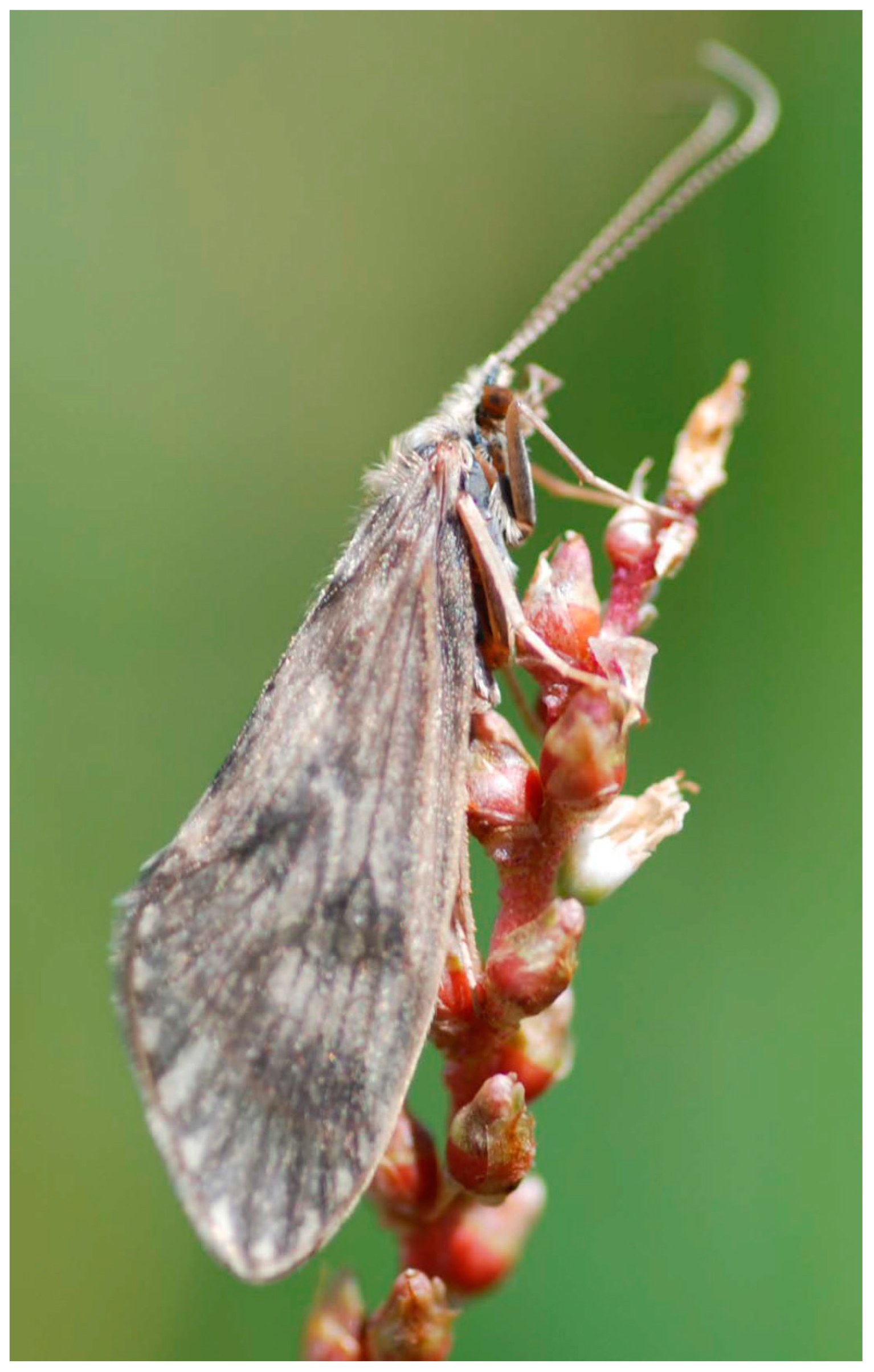
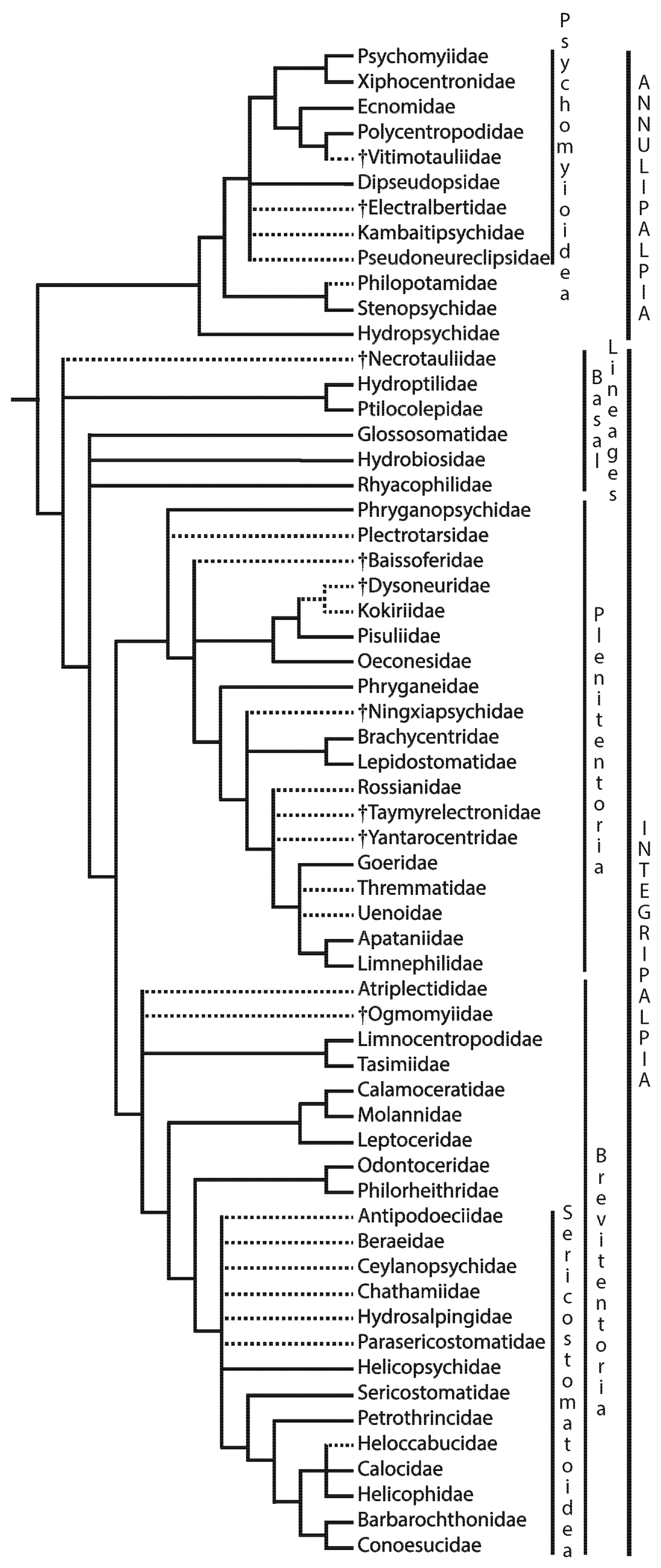
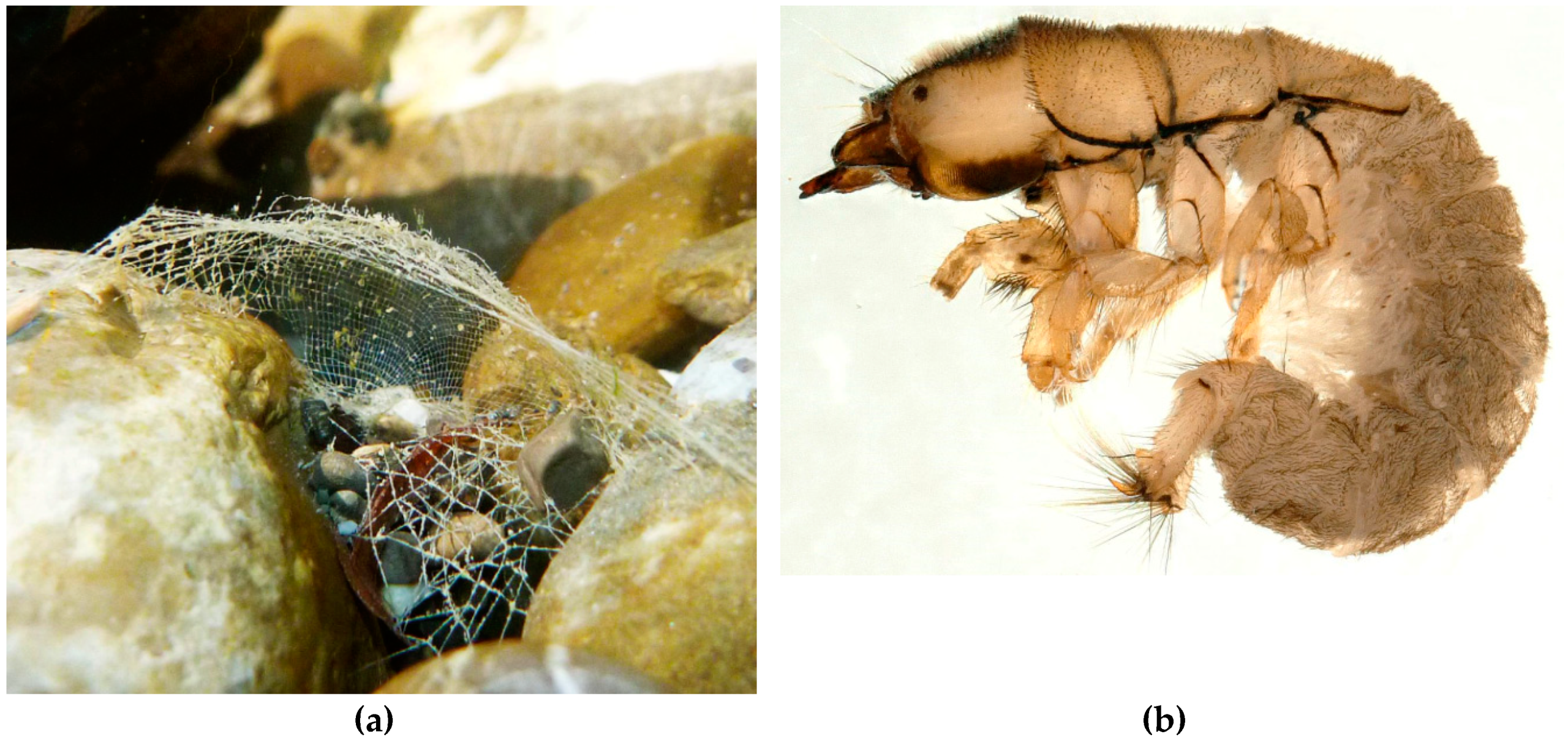
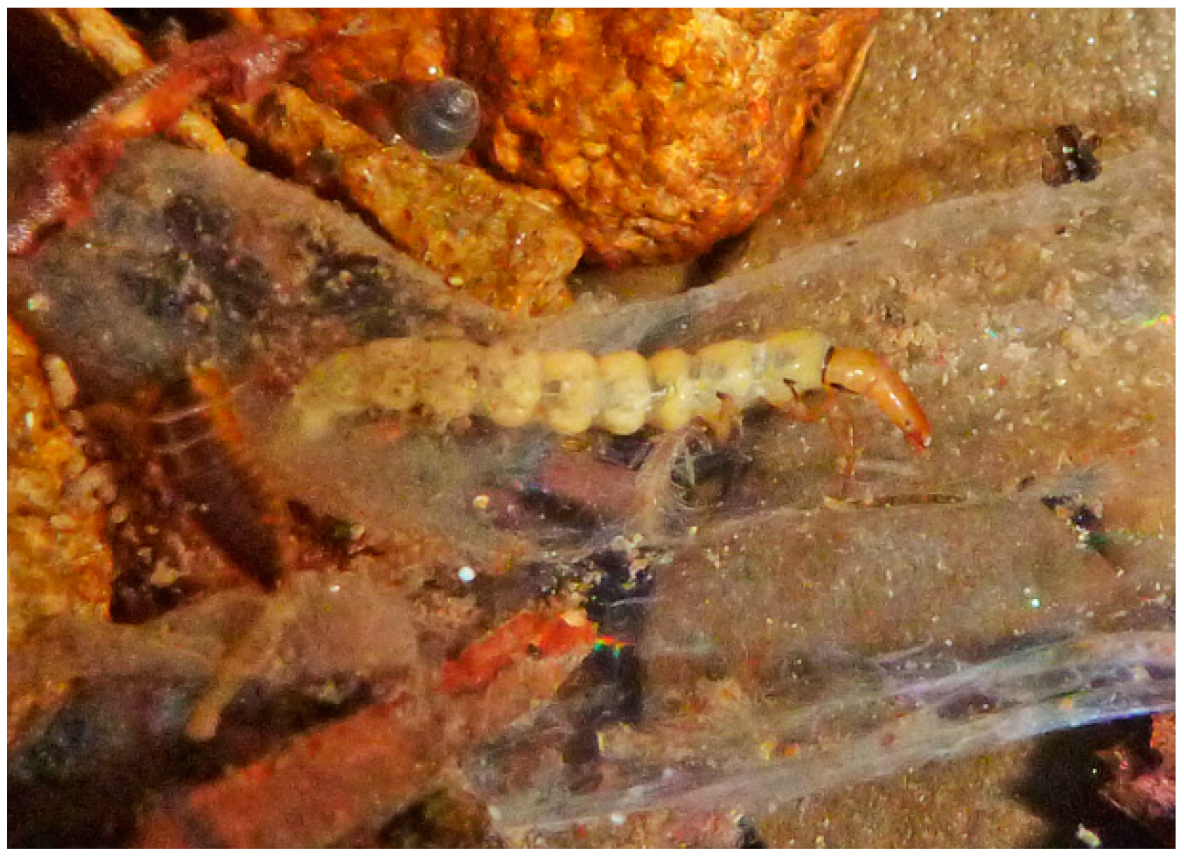

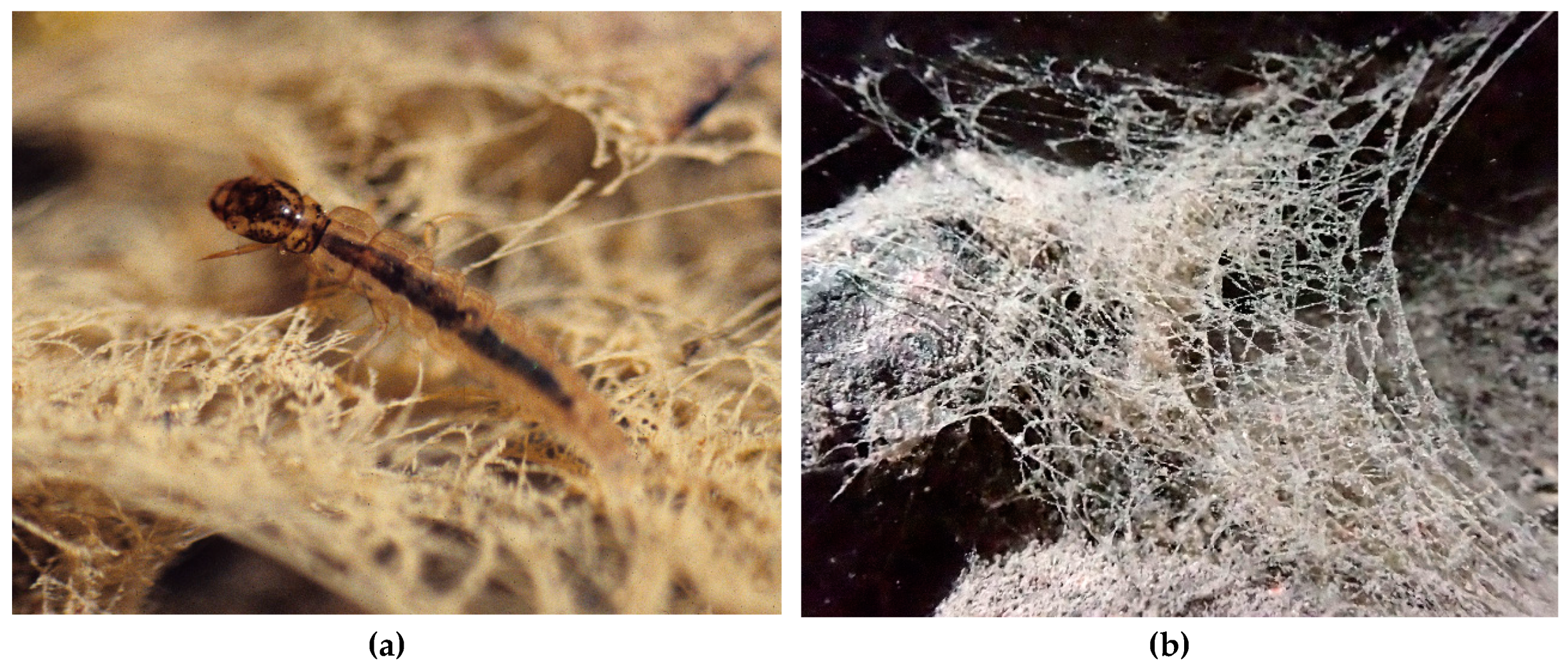
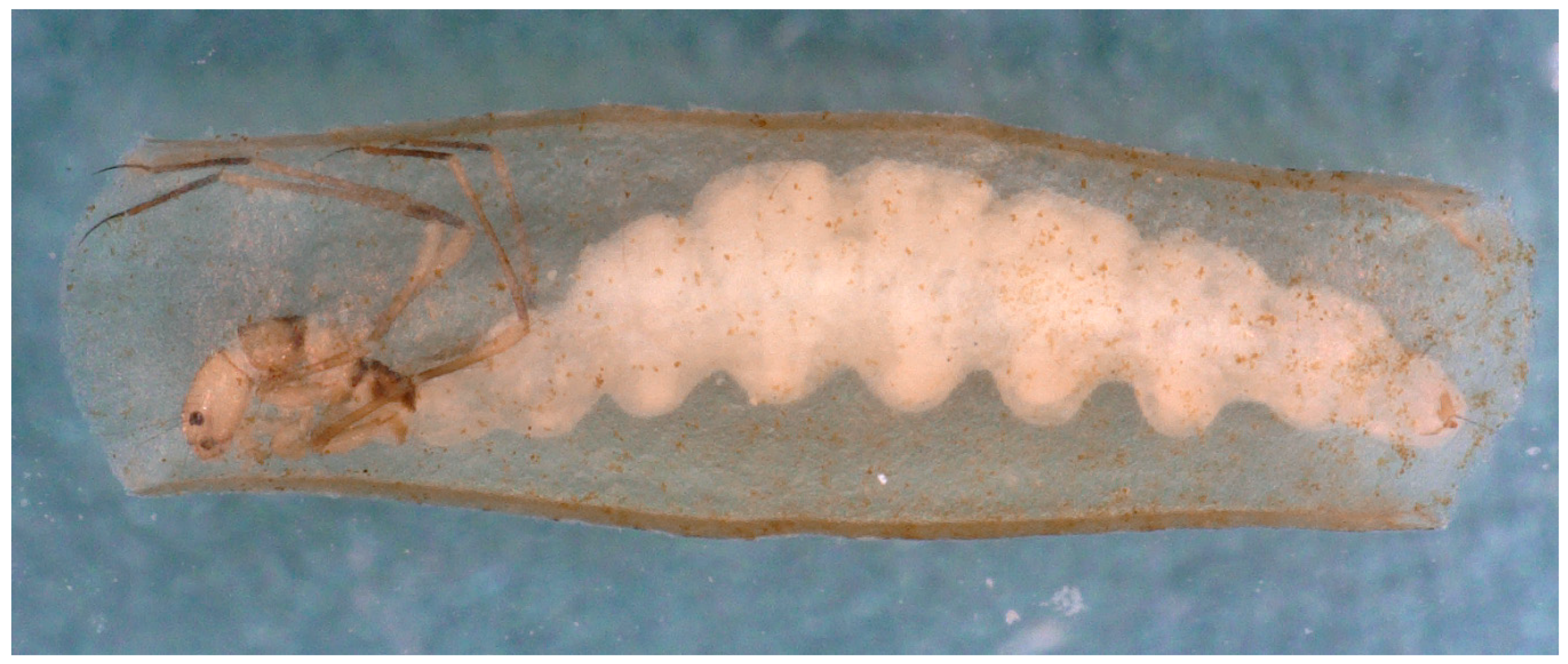
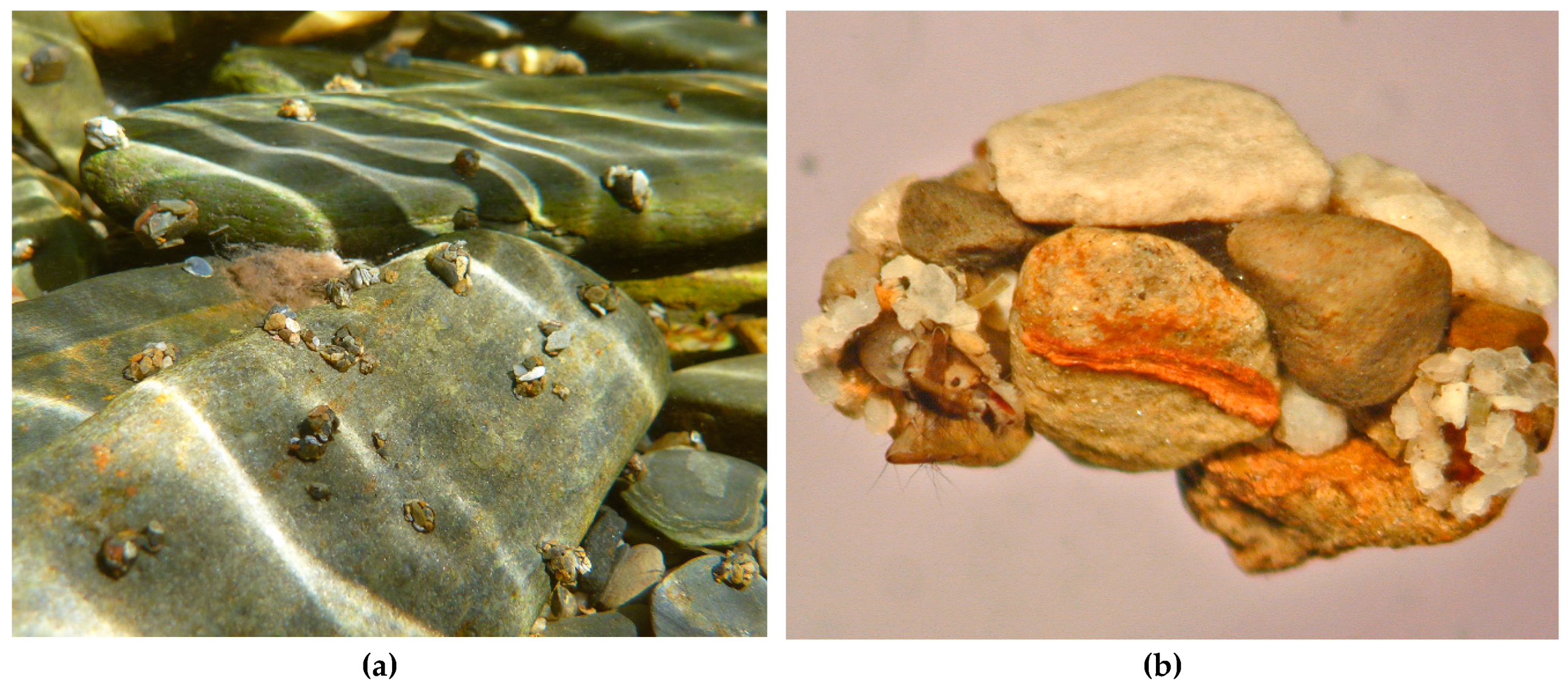
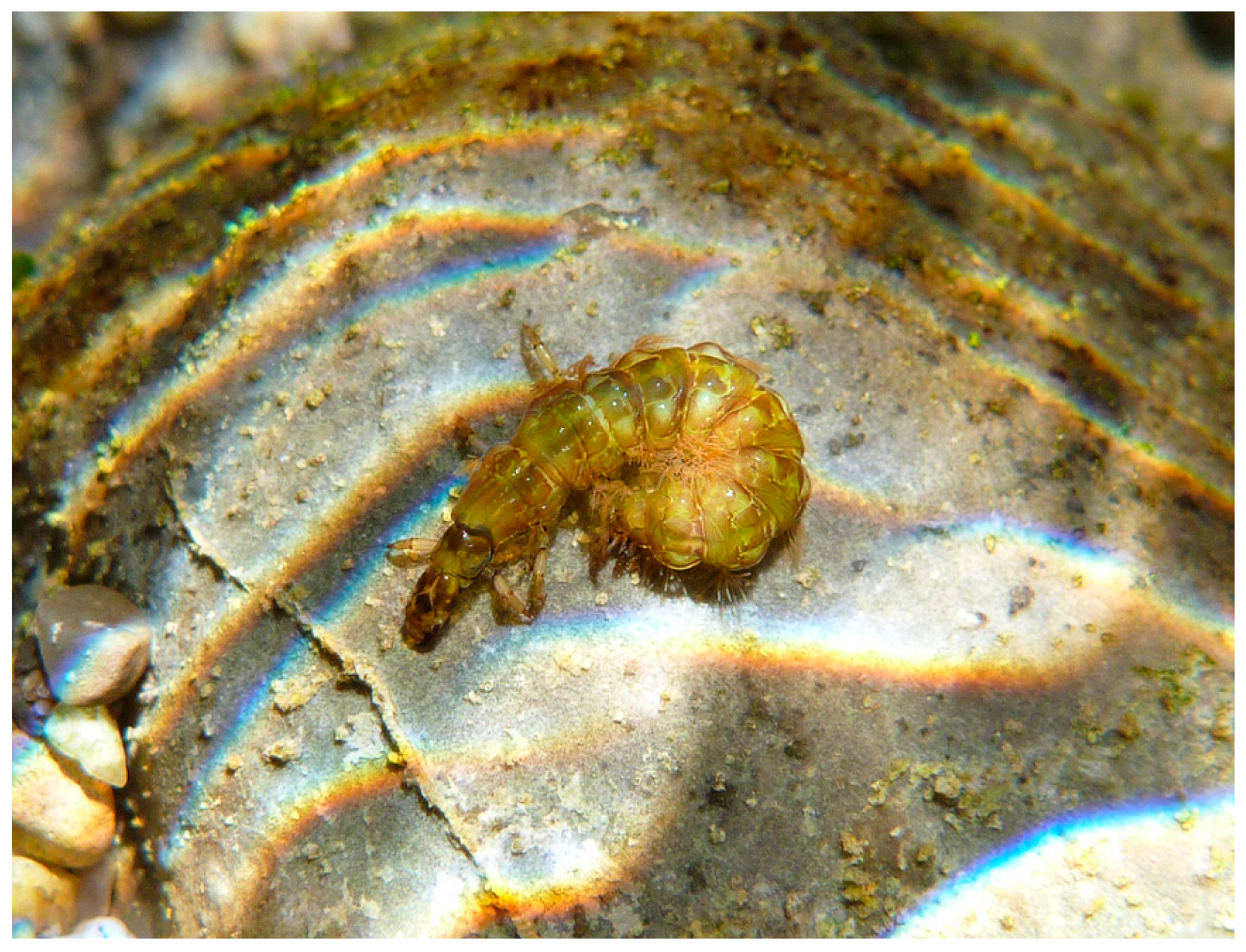
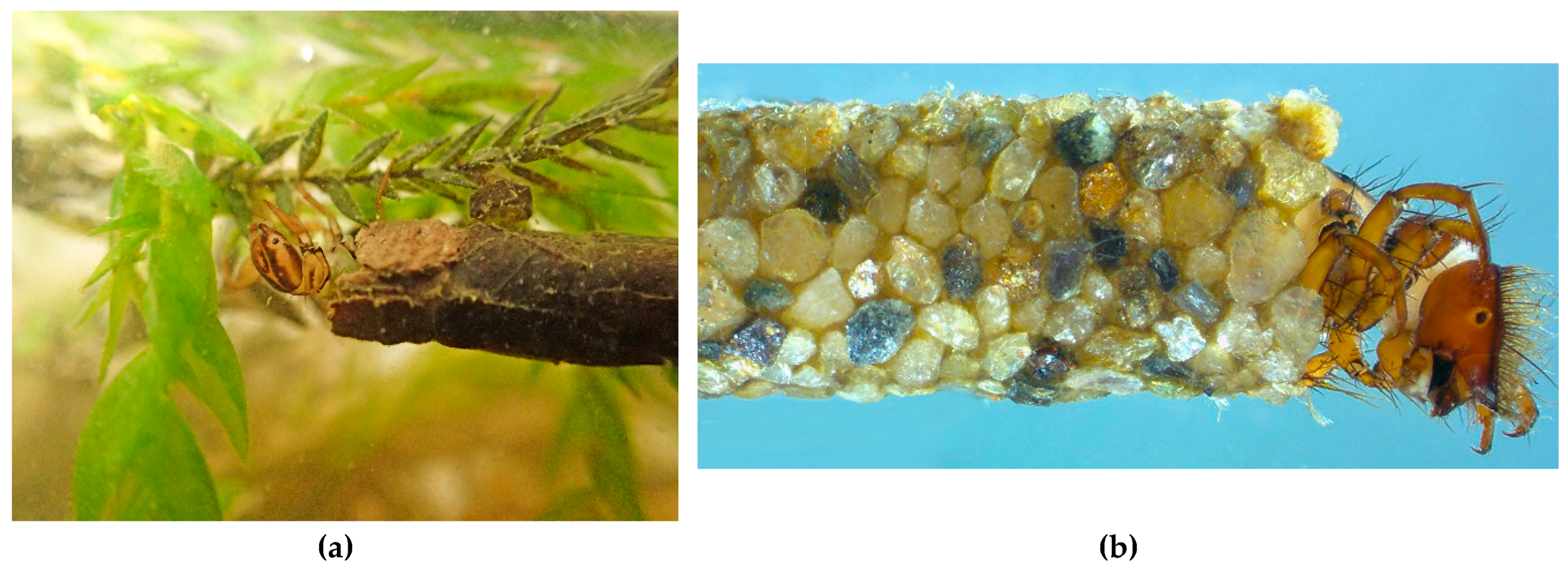
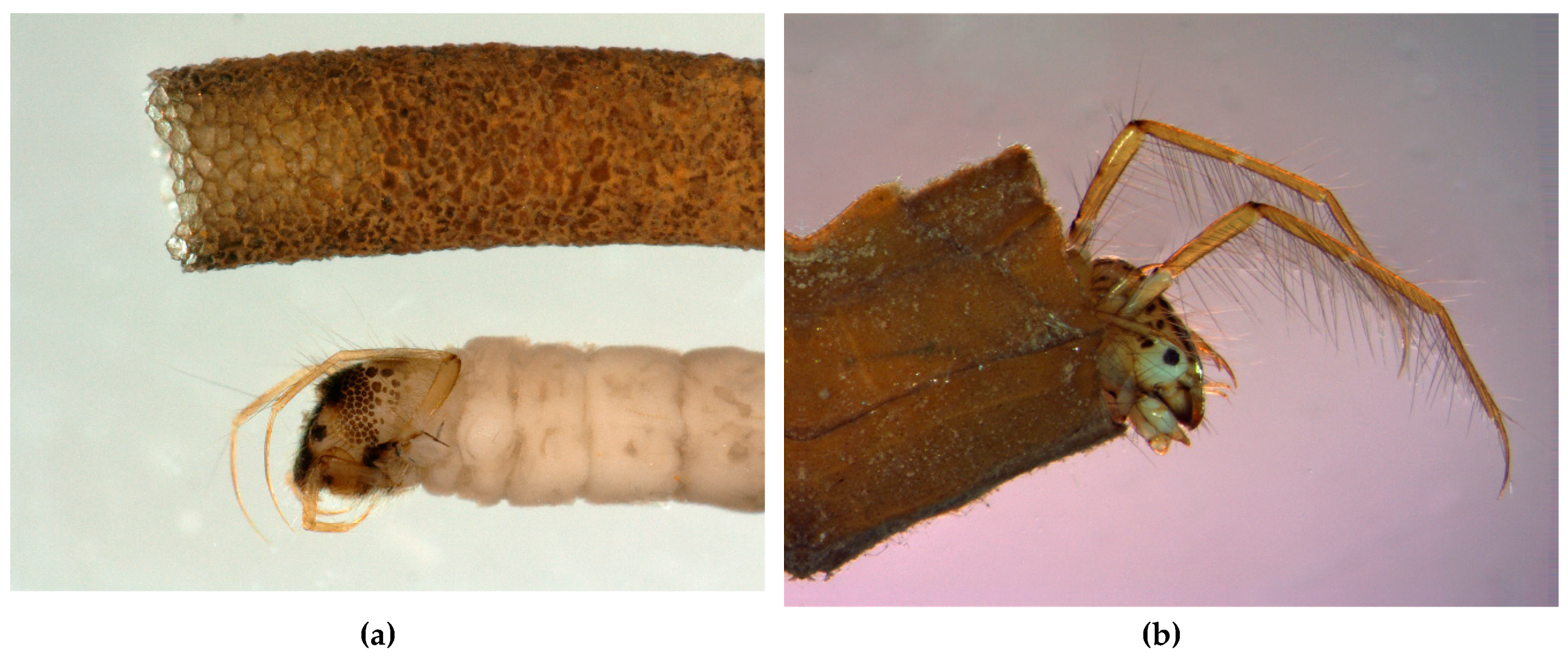
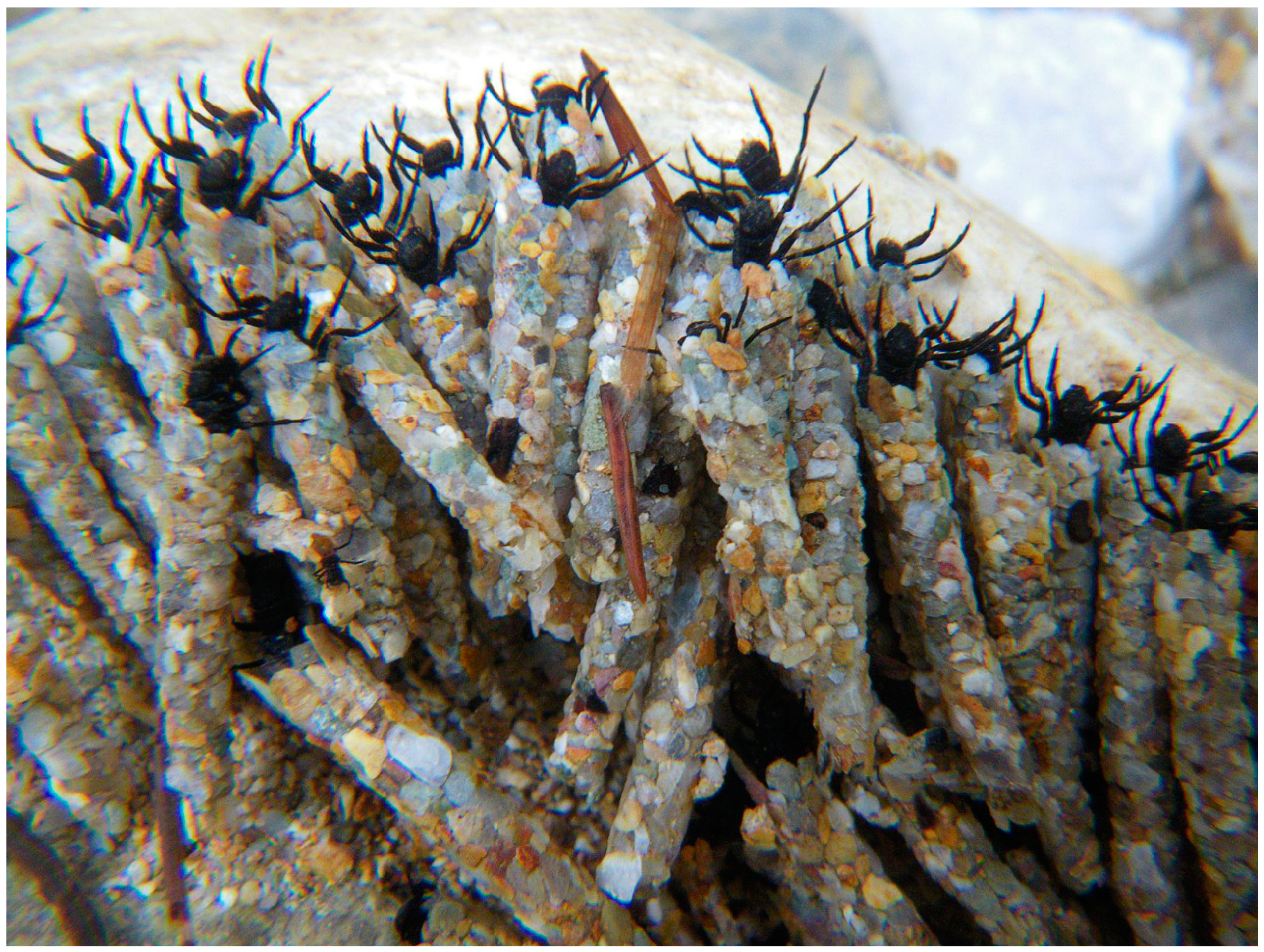
| Families | Earliest Fossils 1 | Mean Geological Age (Ma) 2 | Cases/ Retreats 3 | Feeding 4 | Number of Extant Genera 5 | Number of Fossil Genera 5 | Number of Extant Species 5 | Number of Fossil Species 5 | AT Species 5 | AU Species 5 | EP Species 5 | NA Species 5 | NT Species 5 | OL Species 5 | WP Species 5 |
|---|---|---|---|---|---|---|---|---|---|---|---|---|---|---|---|
| Psychomyiidae | K2 | 77.05 | rt | gra,xyl, gat,pff | 10 | 3 | 600 | 18 | 43 | 12 | 44 | 18 | 0 | 378 | 116 |
| Xiphocentronidae | MI | 21.73 | rt,tm | gat | 7 | 0 | 183 | 1 | 2 | 0 | 3 | 8 | 58 | 116 | 1 |
| Ecnomidae | EO | 35.55 | rt | pre,pff | 12 | 1 | 518 | 22 | 98 | 183 | 4 | 3 | 57 | 169 | 11 |
| Polycentropodidae | K1 | 142.85 | rt,ca | pre,pff | 18 | 11 | 861 | 117 | 21 | 86 | 53 | 9 | 282 | 295 | 72 |
| †Vitimotauliidae | J3 | 148.15 | N/A | N/A | 0 | 7 | 0 | 24 | 0 | 0 | 0 | 0 | 0 | 0 | 0 |
| Dipseudopsidae | K2 | 91.1 | rt | pff | 5 | 1 | 112 | 10 | 51 | 4 | 3 | 6 | 0 | 53 | 2 |
| †Electralbertidae | K2 | 77.05 | N/A | N/A | 0 | 1 | 0 | 1 | 0 | 0 | 0 | 0 | 0 | 0 | 0 |
| Kambaitipsychidae | N/A | N/A | N/A | N/A | 1 | 0 | 2 | 0 | 0 | 0 | 0 | 0 | 0 | 2 | 0 |
| Pseudoneureclipsidae | N/A | N/A | rt | gat? | 2 | 0 | 121 | 4 | 5 | 1 | 3 | 0 | 4 | 99 | 9 |
| Philopotamidae | J1 | 179.3 | fn | pff | 26 | 10 | 1508 | 35 | 150 | 215 | 52 | 76 | 354 | 625 | 65 |
| Stenopsychidae | EO | 35.55 | rt,fn | pff | 3 | 0 | 107 | 1 | 1 | 9 | 26 | 0 | 3 | 83 | 0 |
| Hydropsychidae | EO | 35.55 | rt,fn | pff,pre, gra,gat | 41 | 2 | 1982 | 12 | 221 | 181 | 89 | 173 | 457 | 757 | 171 |
| †Necrotauliidae | TR3 | 222.6 | N/A | N/A | 0 | 9 | 0 | 28 | 0 | 0 | 0 | 0 | 0 | 0 | 0 |
| Hydroptilidae | K1 | 118.5 | fl,pc | pie,gra, gat,pre, shh,par | 74 | 1 | 2570 | 22 | 161 | 337 | 89 | 352 | 921 | 614 | 183 |
| Ptilocolepidae | K2 | 77.05 | fl,pc | shh | 2 | 0 | 16 | 2 | 0 | 0 | 7 | 2 | 0 | 2 | 5 |
| Glossosomatidae | J3 | 148.15 | ps | gra | 20 | 1 | 785 | 10 | 6 | 40 | 73 | 100 | 318 | 181 | 91 |
| Hydrobiosidae | J3 | 148.15 | fl | pre | 51 | 5 | 427 | 6 | 0 | 199 | 4 | 7 | 184 | 38 | 1 |
| Rhyacophilidae | J3 | 158.4 | fl | pre,shd, gra | 5 | 3 | 833 | 14 | 0 | 0 | 122 | 130 | 0 | 469 | 133 |
| Phryganopsychidae | N/A | N/A | pl | shd | 1 | 0 | 4 | 0 | 0 | 0 | 2 | 0 | 0 | 3 | 0 |
| Plectrotarsidae | J3 | 148.15 | pl | shd | 3 | 1 | 5 | 1 | 0 | 5 | 0 | 0 | 0 | 0 | 0 |
| †Baissoferidae | J3 | 148.15 | N/A | N/A | 0 | 1 | 0 | 5 | 0 | 0 | 0 | 0 | 0 | 0 | 0 |
| †Dysoneuridae | J2 | 173.6 | N/A | N/A | 0 | 75 | 0 | 14 | 0 | 0 | 0 | 0 | 0 | 0 | 0 |
| Kokiriidae | N/A | N/A | mn | pre | 6 | 0 | 15 | 0 | 0 | 13 | 0 | 0 | 2 | 0 | 0 |
| Pisuliidae | N/A | N/A | pl | shd | 2 | 0 | 19 | 0 | 19 | 0 | 0 | 0 | 0 | 0 | 0 |
| Oeconesidae | N/A | N/A | pl,mn | shd | 6 | 0 | 18 | 0 | 0 | 18 | 0 | 0 | 0 | 0 | 0 |
| Phryganeidae | J3 | 148.15 | pl | pre,shh, gra,gat | 15 | 7 | 81 | 39 | 0 | 0 | 39 | 28 | 0 | 22 | 18 |
| †Ningxiapsychidae | K1 | 105.8 | N/A | N/A | 0 | 1 | 0 | 1 | 0 | 0 | 0 | 0 | 0 | 0 | 0 |
| Brachycentridae | K1 | 137.05 | pl,mn,si | gra,pff, shh,pre, gat | 7 | 1 | 112 | 2 | 0 | 0 | 30 | 39 | 0 | 31 | 28 |
| Lepidostomatidae | K1 | 127.5 | pl,mn | xyl,shd, gra,pre | 7 | 4 | 519 | 14 | 49 | 3 | 74 | 77 | 22 | 287 | 31 |
| Rossianidae | N/A | N/A | mn | gat,gra, shh | 2 | 0 | 2 | 0 | 0 | 0 | 0 | 2 | 0 | 0 | 0 |
| †Taymyrelectronidae | K2 | 84.65 | N/A | N/A | 0 | 1 | 0 | 1 | 0 | 0 | 0 | 0 | 0 | 0 | 0 |
| †Yantarocentridae | EO | 46.5 | N/A | N/A | 0 | 1 | 0 | 1 | 0 | 0 | 0 | 0 | 0 | 0 | 0 |
| Goeridae | EO | 35.55 | mn | gra,gat | 11 | 0 | 189 | 4 | 2 | 5 | 30 | 12 | 0 | 125 | 18 |
| Thremmatidae | N/A | N/A | mn | gra,gat | 3 | 0 | 53 | 0 | 0 | 0 | 9 | 36 | 0 | 5 | 5 |
| Uenoidae | N/A | N/A | mn | gra,gat | 4 | 0 | 32 | 0 | 0 | 0 | 1 | 20 | 0 | 11 | 0 |
| Apataniidae | N/A | N/A | mn | gra,gat, shd,shh | 21 | 1 | 212 | 1 | 0 | 0 | 83 | 32 | 0 | 70 | 41 |
| Limnephilidae | EO | 35.55 | mn,pl | shd,gra, pre,gat, pff,shh | 97 | 3 | 1037 | 12 | 0 | 2 | 198 | 251 | 43 | 142 | 557 |
| Atriplectididae | N/A | N/A | mn | sca | 4 | 0 | 6 | 0 | 2 | 3 | 0 | 0 | 1 | 0 | 0 |
| †Ogmomyiidae | EO | 46.5 | N/A | N/A | 0 | 1 | 0 | 3 | 0 | 0 | 0 | 0 | 0 | 0 | 0 |
| Limnocentropodidae | N/A | N/A | mn | pre | 1 | 0 | 18 | 0 | 0 | 0 | 2 | 0 | 0 | 17 | 0 |
| Tasimiidae | N/A | N/A | mn | gra,gat | 4 | 0 | 9 | 0 | 0 | 7 | 0 | 0 | 2 | 0 | 0 |
| Calamoceratidae | J3 | 148..05 | pl | shd,gra, pre | 8 | 4 | 190 | 7 | 6 | 34 | 8 | 5 | 76 | 67 | 2 |
| Molannidae | N/A | N/A | mn | pre,gat, gra | 2 | 0 | 42 | 6 | 0 | 0 | 10 | 7 | 0 | 26 | 6 |
| Leptoceridae | K1 | 137.05 | mn,pl,si | shh,pre, gra,gat | 49 | 9 | 2235 | 30 | 353 | 324 | 123 | 130 | 286 | 987 | 125 |
| Odontoceridae | K2 | 84.65 | mn | gra,gat, pre | 15 | 4 | 172 | 8 | 4 | 5 | 14 | 15 | 47 | 89 | 3 |
| Philorheithridae | N/A | N/A | mn | pre | 9 | 0 | 30 | 0 | 3 | 21 | 0 | 0 | 6 | 0 | 0 |
| Ceylanopsychidae | N/A | N/A | N/A | N/A | 1 | 0 | 7 | 0 | 0 | 0 | 0 | 0 | 0 | 7 | 0 |
| Antipodoeciidae | N/A | N/A | mn | gra | 3 | 0 | 34 | 0 | 0 | 1 | 0 | 0 | 33 | 0 | 0 |
| Beraeidae | EO | 35.55 | mn | gat,shd, gra | 7 | 0 | 59 | 3 | 2 | 0 | 1 | 3 | 0 | 0 | 53 |
| Chathamiidae | N/A | N/A | cl | shh | 2 | 0 | 5 | 0 | 0 | 5 | 0 | 0 | 0 | 0 | 0 |
| Hydrosalpingidae | N/A | N/A | si | gat,gra | 1 | 0 | 1 | 0 | 1 | 0 | 0 | 0 | 0 | 0 | 0 |
| Parasericostomatidae | N/A | N/A | N/A | N/A | 2 | 0 | 13 | 0 | 0 | 0 | 0 | 0 | 13 | 0 | 0 |
| Helicopsychidae | EO | 35.55 | mn | gra | 2 | 5 | 281 | 15 | 17 | 53 | 2 | 14 | 116 | 80 | 5 |
| Sericostomatidae | K2 | 84.65 | mn,si | shd,gat, shh,pre | 16 | 4 | 103 | 6 | 19 | 0 | 2 | 16 | 7 | 4 | 58 |
| Petrothrincidae | N/A | N/A | mn | gra | 1 | 0 | 14 | 0 | 14 | 0 | 0 | 0 | 0 | 0 | 0 |
| Heloccabucidae | N/A | N/A | N/A | N/A | 1 | 0 | 1 | 0 | 0 | 1 | 0 | 0 | 0 | 0 | 0 |
| Calocidae | N/A | N/A | mn,pl | gat | 7 | 0 | 33 | 0 | 0 | 33 | 0 | 0 | 0 | 0 | 0 |
| Helicophidae | K1 | 127.5 | mn,pl,si | gat,shh | 9 | 0 | 47 | 0 | 0 | 31 | 0 | 0 | 16 | 0 | 0 |
| Barbarochthonidae | N/A | N/A | si,mn | shd | 1 | 0 | 1 | 0 | 1 | 0 | 0 | 0 | 0 | 0 | 0 |
| Conoesucidae | N/A | N/A | mn,pl,si | gra,shd,shh | 11 | 0 | 42 | 0 | 0 | 42 | 0 | 0 | 0 | 0 | 0 |
| ichnotaxa | J1/J2 | 174.1 | mn,pc,pl | N/A | 0 | 11 | 0 | 265 | 0 | 0 | 226 | 10 | 1 | 0 | 31 |
| TOTALS | 618 | 121 | 16,266 | 765 | 1251 | 1873 | 1426 | 1581 | 3309 | 5854 | 1841 |
© 2019 by the authors. Licensee MDPI, Basel, Switzerland. This article is an open access article distributed under the terms and conditions of the Creative Commons Attribution (CC BY) license (http://creativecommons.org/licenses/by/4.0/).
Share and Cite
Morse, J.C.; Frandsen, P.B.; Graf, W.; Thomas, J.A. Diversity and Ecosystem Services of Trichoptera. Insects 2019, 10, 125. https://doi.org/10.3390/insects10050125
Morse JC, Frandsen PB, Graf W, Thomas JA. Diversity and Ecosystem Services of Trichoptera. Insects. 2019; 10(5):125. https://doi.org/10.3390/insects10050125
Chicago/Turabian StyleMorse, John C., Paul B. Frandsen, Wolfram Graf, and Jessica A. Thomas. 2019. "Diversity and Ecosystem Services of Trichoptera" Insects 10, no. 5: 125. https://doi.org/10.3390/insects10050125
APA StyleMorse, J. C., Frandsen, P. B., Graf, W., & Thomas, J. A. (2019). Diversity and Ecosystem Services of Trichoptera. Insects, 10(5), 125. https://doi.org/10.3390/insects10050125






